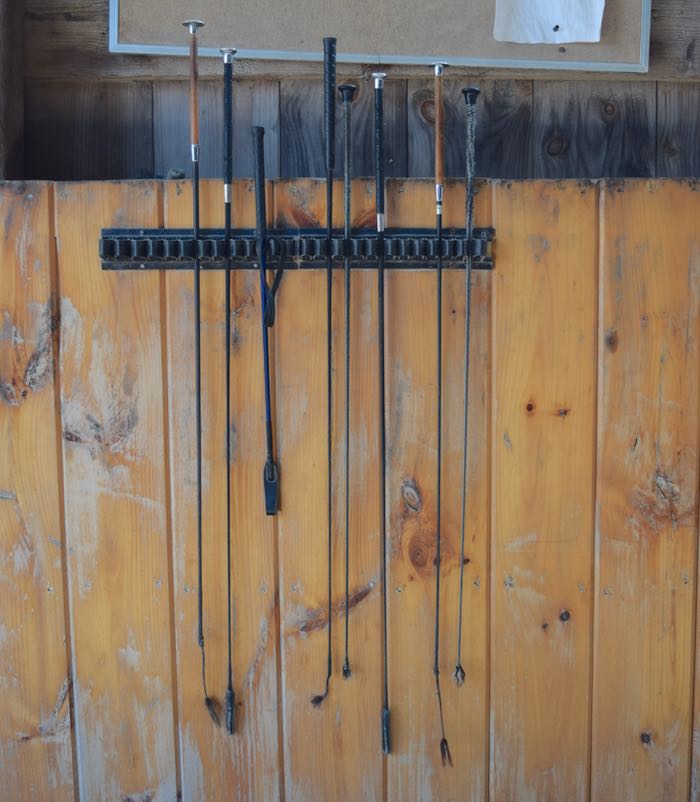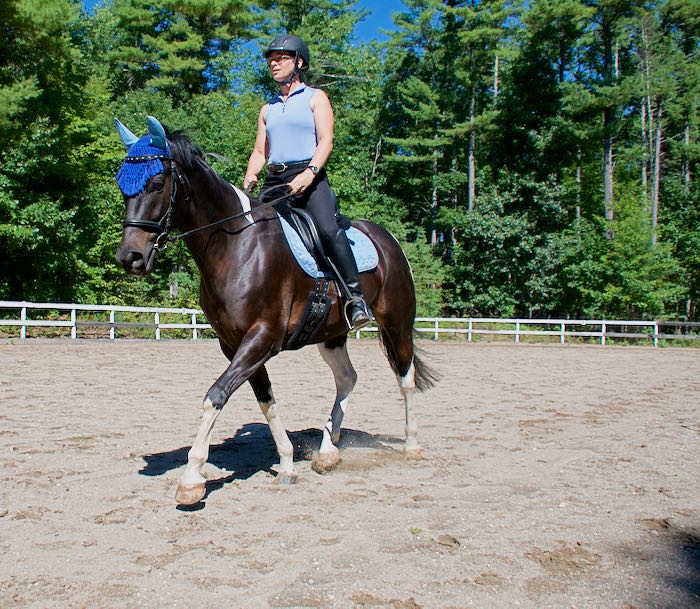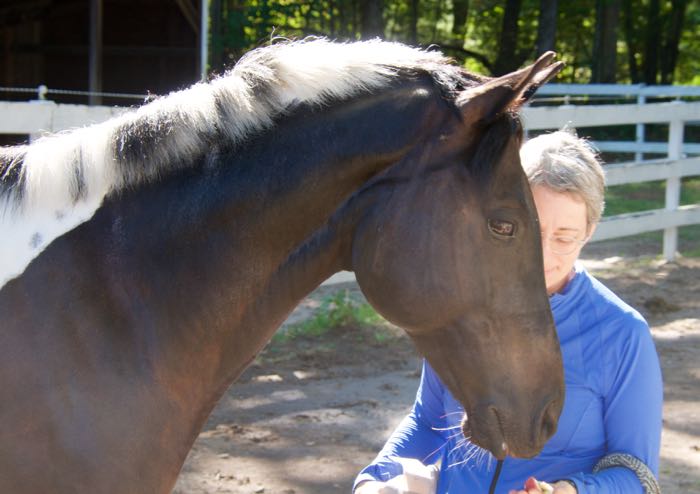This whip holder is at the entrance to the indoor arena where I board Tonka. There’s nothing unusual in this. In my sport of dressage, a rider carries a whip.
We’re taught that if the horse ignores the leg aids (a squeeze, perhaps a jab or a kick) that the next step is to flick the whip across the flank. We’re told that if the horse is lazy, that a whip will wake him up.
A whip can be a cue. Some riders have weak legs. Some riders are so sloppy that a horse can’t possibly figure out what those swinging limbs are telling them to do. A tap is precise and clear. Tap. Go forward. Used in that way, it doesn’t seem like such a bad thing. It isn’t.
However, it’s rarely a tap. The problem with teaching a horse to go forward from the whip is that it’s not taught as a cue – if you move on after you feel this you get a reward. Rather, it’s taught as a threat. Get going and if you don’t, you’ll get hit harder. The problem inherent in this system is that if the horse doesn’t respond to a little tap the only option is to escalate. Tap again. Tap harder. What if he doesn’t respond to that? You whack. It’s no longer a cue. It’s no longer gentle pressure. It’s punishment. It’s a slippery slope that too many riders go down. Thirty-five years ago, I watched my riding instructor get so furious at a horse that he whipped it until he raised welts across that mare’s back. Although I lived in the same staff house with this man for the rest of that summer, I never spoke to him again.
But, I still rode with a whip. I carried a whip while riding many horses, over many years, and I can tell you that it is rewarding for the rider. When you use a crop, the horse, which had been moving sluggishly, surges ahead. This makes you feel successful, but what of the horse? Does the horse enjoy that moment of forward movement? In dressage, we talk about dancing with our horses. If I were dancing with a man, would I dance with him if he hit me? Of course not, and yet we accept this when dancing with our equine partners. My training perspective has changed. I’ve learned that there are other ways to get behavior, ways that are mutually enjoyable for all of the parties involved. It’s a perspective that I learned through clicker training and that I’m now applying it to my work with horses.
But I’m not throwing out everything. What makes riding different from training other animals is that you are sitting on the horse. Body to body contact. It’s complex and nuanced, and that to me is one of the great joys of riding. It’s like this: I feel him swivel his head as we walk through the woods. I know that deer is there before I see it. He feels me change my position an iota, a clue that we’re about to go faster. At a show he sees a flowerpot that scares him. I take a deep breath and he relaxes. As a girl who dreamed of being Dr. Doolittle and talking to the animals, riding is as close as I can get.
Using clicker training techniques, I could train my horse to turn left on a cue – perhaps a word or a touch on the left shoulder with a finger – but I wouldn’t want to. I want to continue to communicate in that complicated, yet hopefully subtle way, from the saddle. For example, when I want to turn to my left, I look that direction, my head moves, my spine rotates, the weight goes down into my left sitting bone, and through to the sole of my boot and into the stirrup. My left leg becomes the support pole that Tonka pivots around. He goes left. It’s not aversive. We’re simply listening to each other’s bodies. The horse remains relaxed and willing.
Add the reins, and we can talk to each other with more finesse. With very small changes in my contact, I can ask for more balance, for a change in rhythm, for a lifting of a shoulder. What I’m talking about takes athleticism and skill. When I first learned dressage, my instructor had me close my eyes and tell her which hoof was hitting the ground. Was the horse breathing in or out? Tune in like that to your horse, and the horse tunes into you. The communication can become instantaneous and magical. I’ve asked a horse to go from a halt to a canter by shifting one sitting bone. It works.
That finesse, though, is hard to come by, and we riders get demanding and impatient, and we end up resorting to pressure (or worse) and then release, and we feel okay about it because we’re told that the release is a reward. Sometimes it is. But how rewarding can it be to the horse to have the same person who has hit him, say “good boy” and – maybe – allow him to take a breather? Not only does punishment has many fallouts (another post!) but this sort of training is not particularly effective. There is a better way. Go ahead and ride using your body, legs, seat and hands, but while you do, pay attention to the good strides and reward them immediately and with clarity. I’ll talk about rewards and how to use them when riding in upcoming posts.
You can put away the whip. Isn’t that a relief?





In barrel racing, and other speed events, looking toward your next obstacle is the primary cue for your horse to turn. At any barrel race, you hear lots of shouts of “LOOK” when the rider is turning. We also find that using a whip, tends to shorten the horses’ stride, which is exactly what we don’t want! Even in speed events, it’s all about the finesse!
Karen Pryor’s granddaughter does barrel racing, and uses positive reinforcement to train her pony.
It is not only Tonka who has the kind eyes. Thank you. It is wisdom that can be applied to all aspects of life.
Yes, this perspective applies to everything and has the potential to make the world a much better place.
How does this apply to horse racing? About which I know little or nothing, except those jockeys really whale away with the whips, and the horses generally appear to run faster.
Glad you asked. There’s been some interesting research showing that whipping does not increase the odds of winning. This comes along with photos that show just how hard the horses are hit. Start with this article.
That’s an interesting article, thanks. I don’t imagine the practice is going to disappear from horse racing any time soon, but one can always hope. There are people, of course, who feel that horse racing in general is abusive to the horse (as well as those who would condemn you for even putting on the saddle and getting on Tonka’s back), but I’ve also heard that (some) race horses love nothing better than to run their hearts out—kind of like sled dogs. I have another question, just because I’m curious—no judgement intended: did you spank your kids when they were young?
Some horses love to run. The question is more nuanced – should they be training and running when so young? Should the 23 hours a day that they’re not on the track be as it is?
As far as spanking – never. I have yelled or grabbed to stop a dangerous behavior (running into the street) but punishment is not only not necessary, it’s not effective and has serious fallout. No further discussion here! :)
Where in the world do you live, Sue? Here in the UK the use of the whip is highly regulated now and overuse is punished. It’s generally accepted that it’s necessary to carry a whip to keep the horses safe if one is veering sideways heading for a crash with another, but they do still use it to make horses go faster, which, as previously discussed, just doesn’t actually work. But the racing industry is a funny old one and traditions die really HARD. Many people still think that a whip makes a horse run faster.
Horse racing has plenty of regulations about the use of the whip, but it’s not banned, and it’s used. This is true in other horse sports as well.
Very interesting blog, I learnt to ride in Canada and we never used a whip only our bodies, voice and reins.
Jess has been eager to tell you she has got a job helping a lady with her 3 horses after school and weekends 5 minutes from where she lives, in return she will be taught to ride to ride western style and also horsemanship. The lady will not use whips or punishment of any kind only rewards, she seems to have the same ethos as yourself..:)
Good for Jess! Some people say they do “natural horsemanship” but it is actually punishing – so if in doubt pay attention to the deeds more than the words.
I use to ride quite often when I was younger and I have never held a whip in my hand. It is more important to use that bond between a horse and rider. It never took much to get my horse to do what I wanted and there was mutual respect. A whip was never necessary.
That’s lovely to hear. Were you a competitive rider or was it trail/pleasure?
Trail and pleasure. I just love the smell of horses. They are beautiful and kind animals.
Terry, I’m starting to love you a little.
Mmmmm, what a beautiful post about the relationship between horse and rider. I had a similar early experience with an abusive dressage instructor (whom I ditched after the incident), but fortunately for me I was also blessed to learn from a Scottish hunter-jumper instructor who taught me many of the best practices you mention in this post. I trained without girth, without stirrups, without saddle, without bridle, every type of practice imaginable to remove dependence on aids and learn to pay attention to my relationship to my horse. What an incredibly rewarding experience, and one that taught me everything I need to know about life. ;)
Terry, thank you again for sharing your lovely words with us. They mean more than you realize.
My only experience with a Scottish trainer was on a pony trek in the Highlands – when I was told, “don’t let your horse stop here, it’s a bog and you won’t get out” I paid attention! It sounds like hit hit gold with your trainer.
I stopped showing a couple years ago (lost interest) but did clicker train and (local schooling) show for quite a few years before that. I wasn’t competitive though, because I was still doing my tests with a loop in my reins, which of course, doesn’t impress judges.
I eventually clicker trained my horse to push on the bit so that what we do looks more like dressage, but so much of what he knows comes from clicker training, and plenty of it isn’t yet on cue, so he’s been known to offer highly reinforced off cue behaviors during tests I think it’s funny, but the mainstream dressage community with their over-riding (funny punny) interest in submission and obedience, doesn’t. :-)
Putting behaviors on cue is as important as the rest of the training! But not as fun :) One thing to realize about behaviors that we say are “thrown at you” (off-cue) is that the reason the animal is doing it is because they’re looking for reinforcement and not getting it within the context of the behavior being taught, so they try something else. Sometimes it’s because they’re stressed and they’re reverting to a known behavior which they’re sure of. So, when I get those off-cue behaviors, (as cute as they might be) I evaluate and adjust my training.